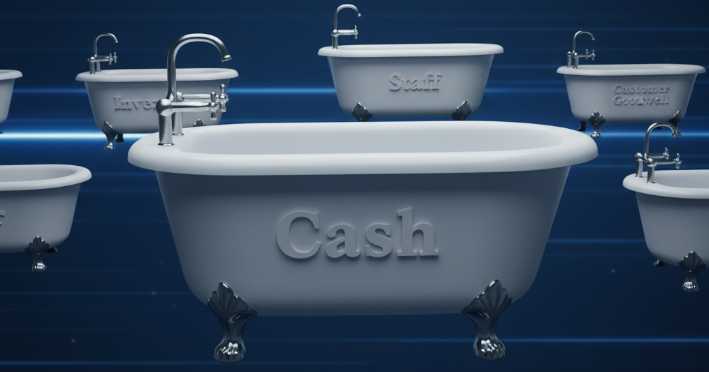I recently hired a landscaper to rebuild a retaining wall on my property. As I thought about his business model, I began to visualize his small business using systems thinking tools, such as a Stock and Flow Diagram, an Iceberg Model, and a Causal Loop Diagram.
Each of these tools provides a business owner with a new lens to uncover the true drivers of business outcomes. The stock and flow diagram is one of the most powerful tools for showing how inputs and outputs affect capacity, cash, or inventory. However, the two other tools are also very useful lenses to apply systems thinking to your business. If you are unfamiliar with either the Iceberg Model or how to create Causal Loop Diagrams, I urge you to check them out as well.
What is a Stock and Flow Diagram
A stock and flow diagram is a way of showing how resources build up or drain away over time. Think of stocks as “containers” in your business. Cash in the bank. Employee capacity. Customer goodwill. Jobs in the pipeline.
Flows are the “pipes” that fill or drain those containers. Sales and receivables add cash. Expenses drain it. New hires add employees. Quits or layoffs drain them.
When you map these out visually, you start to see that the health of your business isn’t about single events. It’s about the relationship between stocks and flows. If a stock is dropping, you can only do three things: increase the inflow, decrease the outflow, or both.
The Bathtub Analogy
I often explain the concept of stock and flow using a bathtub analogy. Imagine each stock in your business as its own tub. Every tub has a faucet and a drain. The faucet fills the tub. The drain empties it. If the water level is dropping, you either need to turn up the faucet, plug the drain, or both.
But not all tubs are alike. Some are renewable. Some are finite. Some are limited by flow. Some are limited by stock. Knowing which kind of tub you are managing changes everything.
Renewable Stock
Customer goodwill is renewable. When my landscaper finished the retaining wall, I was satisfied and would recommend him to a neighbor. That goodwill is like water in the tub. Even if a mistake had been made, an apology or a fair adjustment could turn the faucet back on. Goodwill, therefore, is an example of a renewable stock since it can be replenished over time as long as you consistently deliver value.
Finite Stock
Cash reserves, in contrast, are finite. In the case of the landscaper, if he drains the bank account in January, he can’t simply “turn up the faucet” to refill it. Even if a new snow removal contract comes in, the cash won’t arrive fast enough to instantly solve the problem. That makes cash reserves a fragile, finite tub. You have to guard the finite tub carefully in the good months so that it doesn’t run dry in the lean months.
Flow-Limited Stock
Some tubs are limited by flow. In landscaping, that could be daylight and weather. You can only get so much done in a day. You can’t mow in the dark, pour concrete in a snowstorm, or work long hours in extreme heat. The faucet is capped by nature itself. No matter how many jobs the phone produces, the inflow is limited by daylight and workable weather.
Stock-Limited Stock
Other tubs are limited by stock. In the landscaper example, it’s the crew capacity. A five-person team can only complete so many jobs in a week. Even if more work is available, the tub can only hold what the crew can handle. To expand, you have to enlarge the tub itself by hiring more people, adding more trucks, or building stronger systems.
The Conversation I Wanted to Have
At the end of the landscaping job, I made the same offer I often make when I hire a small business. I told the owner, “If you’d like to sit down for a couple of hours, no charge, I’d be happy to discuss ways to improve your business and economic model. We could talk through your business and maybe uncover some ways to make it run smoother.”
Most owners thank me politely but never follow up. Only a handful ever take me up on my offer. Unfortunately, so far this landscaper hasn’t. But I kept thinking about what I would have said if he had, because the challenges in his business were written all over his operation.
I would have shown him that his problem isn’t just that sales fall in the winter. The real issue is that his business is built on tubs that fluctuate seasonally.
In summer, the faucet is wide open. Work pours in. The crew is maxed out. The cash tub fills quickly. By winter, the faucet slows to a drip. Snow plowing provides some inflow, but it’s inconsistent. Meanwhile, drains are still running. Expenses keep flowing out. Employees are laid off, and some never return. By spring, he is scrambling to refill the crew tub and rebuild capacity.
If we had drawn his business as a stock and flow diagram, it would have been clear why the frantic pace of summer never carried him through the winter. Discounts in January won’t fix daylight limits. Coupons in July won’t expand crew capacity. Short-term tactics don’t change the system.
The real solutions come from smoothing the flows and protecting the tubs that matter. Steadier snow plowing contracts. Year-round maintenance agreements. Saving more cash in summer to build a bigger winter reservoir. Protecting goodwill so the faucet of referrals keeps running.
How I Help Clients Visualize Their Business
This is exactly the kind of work I do when I mentor many small business owners. I help them see their business in new ways by turning abstract problems into visual models.
The way I help clients build a stock flow diagram is with the assistance of ChatGPT and a tool that renders Graphviz diagrams.
- Step 1: I begin by explaining to ChatGPT the basics of a client’s business in a short prompt.
- Step 2: I then paste a prompt that I have developed that tells ChatGPT that I want it to produce a stock flow diagram and to use first principles to break down the processes into their component elements. Included in this prompt, I instruct ChatGPT to produce the DOT code, which is a simple text format, to create the diagram.
- Step 3: I paste that code ChatGPT created into a free tool called Sketchviz, which runs on Graphviz, and it renders the diagram in seconds.

Once an owner sees their cash, employees, customers, and reputation as bathtubs with faucets and drains, the lightbulb goes on. They realize that the ups and downs of their business aren’t random. They are the predictable result of how stocks and flows are managed.
That shift, from reacting to symptoms to managing systems, is why stock and flow diagrams belong in every small business owner’s toolbox.
Have you produced a Stock Flow Diagram for your business?












